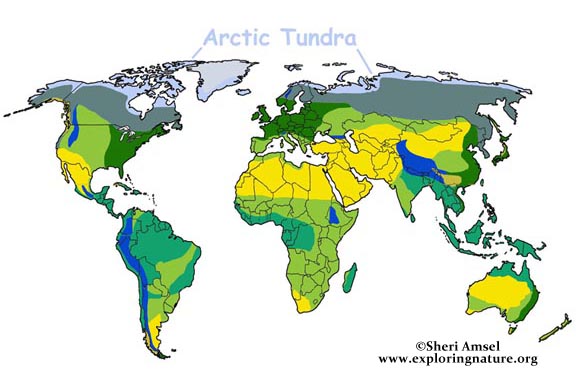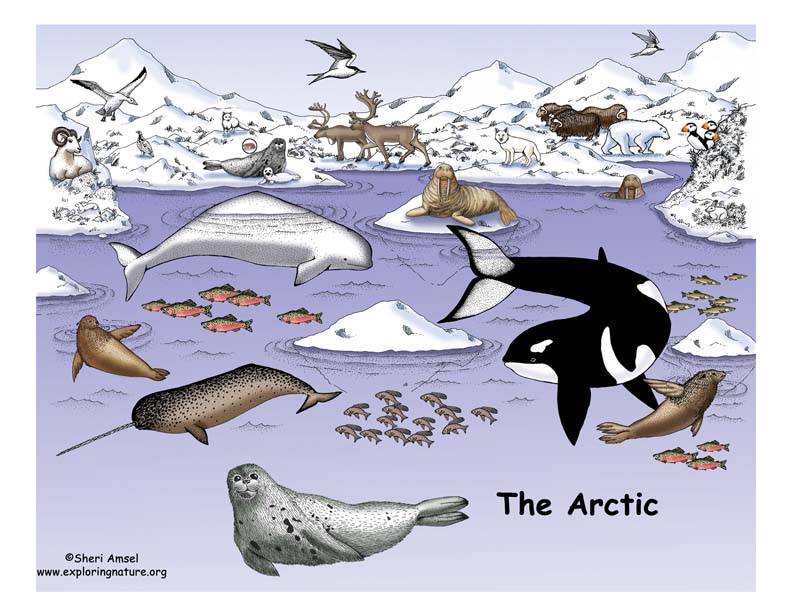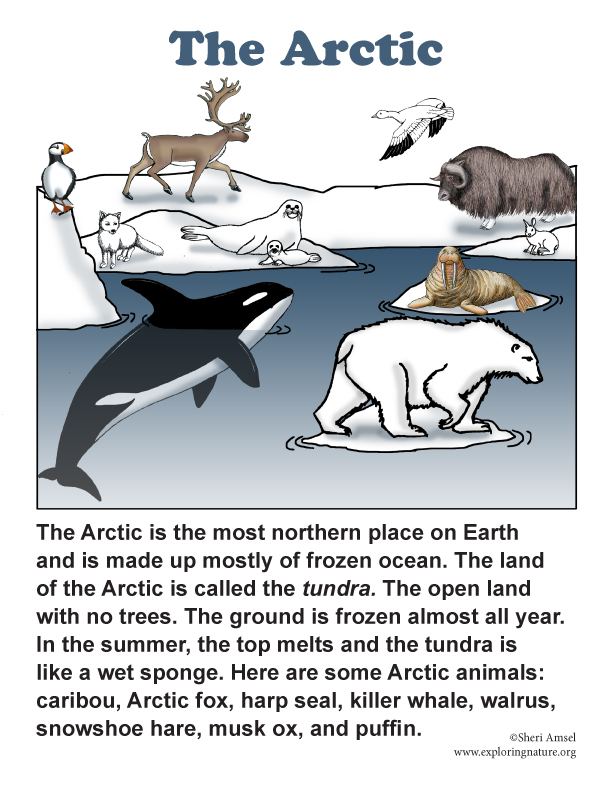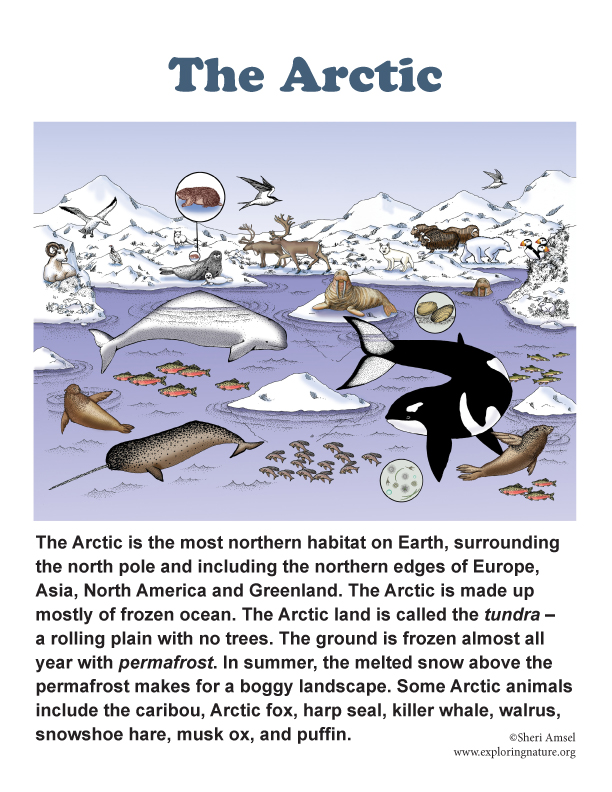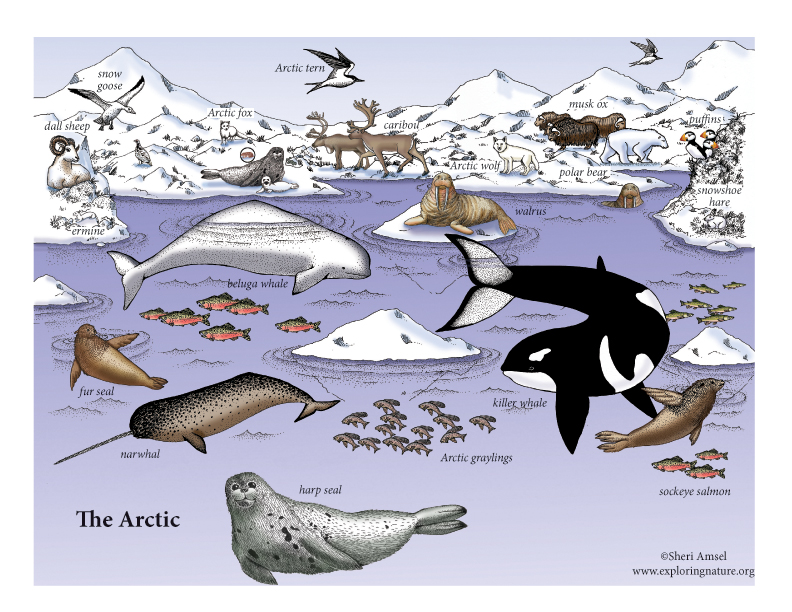

Northernmost point on Earth, surrounding the north pole and including the northern edges of Europe, Asia, North America and Greenland.
The arctic is a habitat that is made up of almost no land at all. It is mostly frozen ocean. The ice pack of the arctic is about 9 feet thick (3 M). In the summer the polar ice pack drifts in the ocean under 24-hour daylight. In the winter it freezes solid, in 24-hour darkness. The arctic has no mountains, but includes the North Pole, the northernmost point on earth. The tallest spot is at sea level, an elevation of 0.
The part of the arctic that is land is called the tundra and includes some northern islands and the northern edges of Europe, Asia, North America and Greenland. The arctic tundra has no trees and the ground is frozen almost all year long with permafrost. The top layer of the soil, above the permafrost, does melt in the summer and grows hearty plants in the short 2-month growing season. Because the frozen permafrost sits below the soil, there is no place for melted snow to go, so the arctic tundra stays wet and boggy in the summer months. This makes it hard to walk on and a perfect habitat for water-born insects like mosquitoes. The mosquito season on the tundra may be short, but it is fierce!
Many animals have adapted for life on the tundra including the: musk ox, caribou, lemming, arctic fox, arctic hare, tern, ptarmigan, snowy owl, arctic wolf, narwhal, walrus, and polar bear. Some animals like the polar bear survive the long, cold winters by hibernating. Others, such as the caribou, arctic wolf, fox and musk ox develop thick winter coats against the cold. The caribou use their sharp hooves to scrape away snow and ice to get to the grass underneath. Thay also have wide, hooves that help keep them above the snow, like snowshoes, so they can move across the tundra quickly. Many animals, such as ptarmigan and snowshoe hare, turn white in winter to blend in with the snowly landscape. The arctic ocean animals have thick layers of blubber to keep them warm in the frigid water. Animals have to be well adapted for survival in this extreme habitat.
The arctic tundra is a fierce habitat for plants too. They have to be able to survive long months of freezing temperatures, winds that dry them out in the winter and boggy melting permafrost conditions in the summer. Plants of the arctic include: arctic willow (shrub), arctic poppy, moss, cushion plants (which grow tight and low to the ground), like saxifrage, and moss campion. Another important food source for caribou that grow on the Arctic tundra are lichens. Lichens are plant-like but are actually a combination of fungus and algae working together to survive in some pretty extreme habitats.
Critical Thing Questions:
1. Name two physical adaptations that help animals survive on the Arctic tundra.
2. Can you think of things humans have made to mimic the physical adaptations of the caribou for walking across the winter tundra?
3. Describe two summer features of the tundra that make it a challenging place to live.
Related Activity:
Coloring Page
Arctic Hidden Picture
Arctic Word Search
Related Visual Aid:
Arctic Download Hi-Res In-Habitat Poster
Related Testing and Assessment:
Arctic Animal Labeling Page
Arctic Read and React Quiz
When you research information you must cite the reference. Citing for websites is different from citing from books, magazines and periodicals. The style of citing shown here is from the MLA Style Citations (Modern Language Association).
When citing a WEBSITE the general format is as follows.
Author Last Name, First Name(s). "Title: Subtitle of Part of Web Page, if appropriate." Title: Subtitle: Section of Page if appropriate. Sponsoring/Publishing Agency, If Given. Additional significant descriptive information. Date of Electronic Publication or other Date, such as Last Updated. Day Month Year of access < URL >.
Amsel, Sheri. "Arctic and the Tundra" Exploring Nature Educational Resource ©2005-2024. December 13, 2024
< http://exploringnature.org/db/view/1739 >
